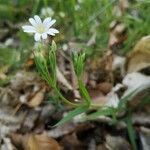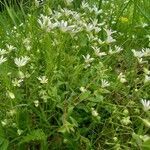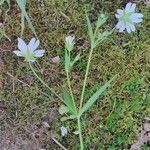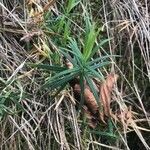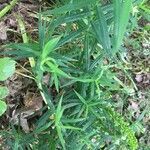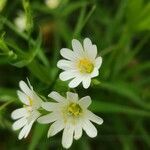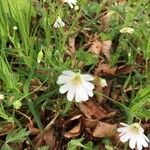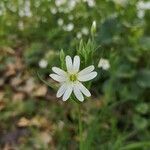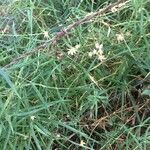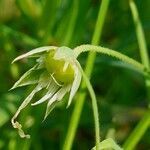Plants perennial, scrambling to ascending, from slender, creeping rhizomes. Stems branched dis-tally, 4-angled, 15-60 cm, glabrous or hispid-puberulent distally. Leaves sessile; blade narrowly lanceolate, widest near base, 4-8 cm × 2-10 mm, somewhat coriaceous, base round and clasping, margins and abaxial midrib very rough, apex narrowly and sharply acuminate, scabrid, otherwise glabrous, slightly glaucous. Inflorescences terminal, loose, 3-31-flowered cymes; bracts foliaceous, 5-50 mm, margins and abaxial midrib scabrid. Pedicels ascending, 1-60 mm, slender, pubescent. Flowers 20-30 mm diam.; sepals 5, inconspicuously 3-veined, ovate-lanceolate, 6-8 mm, margins narrow, scarious, apex acute, glabrous; petals 5 (rarely absent), 8-14 mm, longer than sepals, blade apex 2-fid to middle; stamens 10, sometimes fewer by degeneration; styles 3, ascending, ca. 4 mm. Capsules green, subglobose, 5-6 mm, ± equaling sepals, apex obtuse, opening by 3 valves, tardily splitting into 6; carpophore absent. Seeds reddish brown, reniform, 2-3 mm diam., papillose. 2n = 26 (Europe).
More
Rhizomatous perennial, 1.5–4.5 dm, the 4-angled stems glaucous and sometimes sparsely hispidulous; lvs narrowly lanceolate, sessile, 2–8 cm × 2–10 mm, hispidulous on the midrib and margins, otherwise sparsely puberulent and glabrate; infl open, the ciliate bracts herbaceous; pedicels pubescent, slender, 2–7 cm; sep broadly lanceolate, 6–9 mm, acute, glabrous, obscurely 5–11-veined; pet conspicuously exceeding the sep, notched less than half-way to the base; seeds 2–2.5 mm, obliquely reniform, coarsely papillate; 2n=26. Native of Eurasia, often escaped from cult. in our range. Apr.–June. (Alsine h.)
A herb. It grows 50 cm tall. The leaves are long and narrow. The flowers are white and 2-3 cm across. There are 5 petals spli about half way down.
